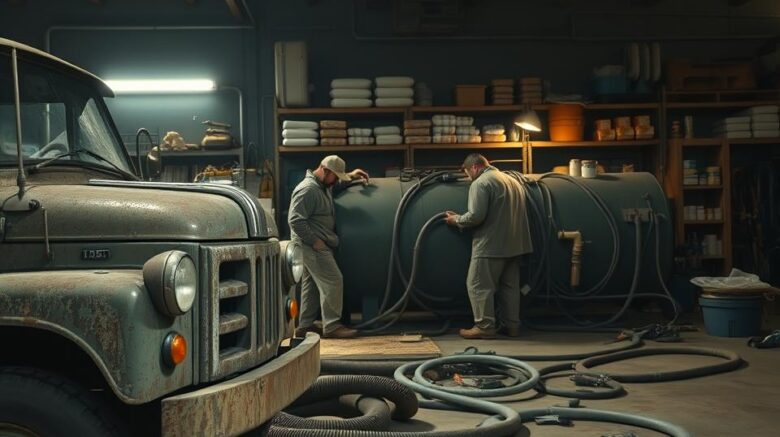Aerobic System Air Pump: Essential Guide for Householders
Have you ever wondered what drives your aerobic septic system’s output? The Septic tank aerator is the unsung champion indispensable for your system. In this article, homeowners will acquire essential information on the aerator’s importance. It’s essential for a sound, optimized Septic system.
Appreciating the significance of a Septic tank air Pump can enhance your Septic system’s capabilities using septic pumping near me. It also safeguards your property’s value and local environment. The following guide will highlight All in Sanitation, a reputable Septic industry specialist. They’re eager to fulfil your Septic aerator Pump needs.
Notable Observations
- The Septic air Pump is indispensable for aerobic Septic systems.
- Maintaining your Septic system air Pump can enhance overall system operation.
- Routine inspections lengthen the lifespan of your Septic tank air Pump.
- Picking the proper Septic aerator Pump is necessary for maximum operation.
- All in Sanitation delivers dedicated services for Septic air Pump needs.
Breaking Down Aerobic Septic Solutions
Aerobic Septic systems offer a enhanced waste treatment approach by supplying oxygen. This process features aerobic bacteria thriving in well-oxygenated environments. These bacteria are more efficient in decomposing organic matter. With the help of Septic aerator Pumps, these systems provide a continuous oxygen supply, accelerating the waste decomposition process.
These systems shine in minimizing sludge buildup, due to the efficiency of aerobic bacteria. This decrease in solid waste means minimal cleaning and Pumping is necessary. Additionally, they successfully handle wastewater, producing reduced odors. This yields a more pleasant environment for homeowners and the community together.
To guarantee these systems work smoothly, it’s crucial to understand the key Septic system components. These include the Septic tank, oxygenation chamber, and effluent Pump. Each component serves a key function, especially the air Pump. It pushes oxygen into the tank, essential for the aerobic bacteria’s activity.
Significance of the Septic Air Pump
The Septic air Pump is crucial in the performance of aerobic Septic systems. It serves as the system’s “oxygen source,” pushing the needed oxygen mandatory. This oxygen allows aerobic bacteria to prosper and digest waste effectively. If the Pump malfunctions, the system’s capability diminishes, bringing about sludge increase and possible odors.
Such issues can disrupt Septic system operations and cause environmental hazards. By recognizing how vital the Septic air Pump is, homeowners can act preemptively. They can keep its top function through scheduled service. This wards off failures, prevents costly repairs, and protects the aerobic system’s condition.
Major Benefits of Using a Septic Air Pump
Utilizing a Septic air Pump notably enhances the effectiveness of Septic systems. Septic air Pumps are vital as they fast-track the processing of waste. This is accomplished by oxygenating the treatment process, promoting aerobic bacteria growth. These bacteria are vital for proper waste treatment.
They’re also useful in lowering foul smells. Thanks to more active aerobic processes, waste is processed faster, thus lessening odors. This ensures better surroundings for homeowners.
Another significant benefit is the cut in sludge buildup. Consequently, tanks need less frequent Pumping, saving both money and time. Greater processing not only lowers bills but also lengthens the lifespan of the drain field.
Proper care of these Pumps diligently means fewer repair costs and complying with regulatory standards. Thus, the benefits of Septic air Pumps aren’t just for homeowners. They also support environmental health by improving waste management practices.
| Benefit | Description |
|---|---|
| Fast Waste Breakdown | Enhanced aerobic activity accelerates the decomposition process. |
| Minimized Odor Emissions | Superior treatment efficacy creates fewer odors. |
| Reduced Sludge Buildup | Less frequent Pumping and maintenance are needed. |
| Extended Drain Field Life | Better treatment translates to a healthier drain field. |
| Cost Savings | Lower chance of repairs and regulatory compliance cost. |

Selecting the Best Septic Air Pump
Picking the proper Septic air Pump is essential for an well-running aerobic system. Homeowners ought to review various factors for the proper choice. The size of the tank and the airflow requirements significantly influence the Pump’s effectiveness.
To select well, it’s useful to understand the air Pumps available. There are mainly two types: linear diaphragm Pumps and rotary vane Pumps. Each delivers distinct advantages, which should be suited with your home’s specific needs and how it operates.
Energy efficiency also is a factor. Opting for a Pump that minimizes energy use while providing the needed airflow can offer meaningful reductions. Help from All in Sanitation specialists can be extremely useful. They verify the Pump you choose matches your system’s requirements precisely.
Common Types of Septic Air Pumps
Homeowners can select wisely by understanding the distinct Septic air Pumps available. There are mainly two types: diaphragm Pumps and rotary vane Pumps. Each has its particular functions and benefits.
Diaphragm Pumps, valued for their hushed operation, are favored for residential Septic systems. They offer energy efficiency while delivering reliable air delivery. Their dependable performance is ideal for smaller systems, meeting the needs of many homeowners.
Rotary vane Pumps, however, are ideal for larger or commercial systems. These Pumps deliver more power, necessary for handling bigger loads. Their durable build delivers efficient operation in broad Septic systems.
| Type of Pump | Best Use | Advantages |
|---|---|---|
| Diaphragm Pumps | Residential Systems | Quiet operation, energy-efficient, reliable air flow |
| Rotary Vane Pumps | Larger or Commercial Systems | Powerful performance, high capacity, durable construction |
Appreciating the variations in Septic air Pumps is vital for upgrades or replacements. Each Pump type delivers particular attributes to meet various needs. This guarantees top performance for any system.
Indicators You Require a Septic Air Pump Replacement
Homeowners must monitor Pump failure signs in their Septic systems. Some indicators suggest the need for a Septic air Pump replacement. These ensure continued performance. Catching these promptly prevents major issues.
Signs of potential problems include:
- Unusual noises from the Pump, like clanking or buzzing, might show internal damage.
- A clear lack of air output suggests the Pump isn’t operating efficiently, harming efficiency.
- Regular electrical problems, such as tripped breakers or voltage drops, could show overloading.
- Visible damage on the Pump unit, with splits or leaks, needs quick action.
- Foul odors in the yard often reveal a compromised Pump, meaning ineffective effluent aeration.
Recognizing these signs early heads off costly fixes or total system failure. Conducting consistent assessments helps spot these issues. It also shows if you need a new Septic air Pump.
Care Guidelines for Your Septic Air Pump
For an effective Septic air Pump, regular maintenance is necessary. This ensures that your system operates correctly. Homeowners can employ several easy-to-follow care strategies for optimal results.
Bi-annually, conduct a careful inspection for wear or damage. It is also important to replace the filters as suggested. This reduces clogs that could hurt efficiency.
The Pump should stand on a stable base to lessen vibrations, which could wear it over time. A protective cover is important too. It shields against debris and water, maintaining the Pump’s functionality.
Good upkeep can considerably lengthen the life of your Pump. In turn, this enhances the Septic system’s performance as a whole.
| Maintenance Task | Frequency | Benefits |
|---|---|---|
| Inspect Pump for damage | Every 6 months | Finds faults promptly |
| Replace filters | As needed | Enhances operation |
| Check surface stability | Annually | Limits wear |
| Clear debris around Pump | Monthly | Avoids obstruction |
Fitting Your Septic Air Pump
Proper installation of your Septic air Pump is key for its smooth operation. Initially, pick a safe, moisture-free area for placement. The chosen spot should firmly hold the Pump’s weight without issue.
To reliably set up your Pump on your own, heed the following guidelines:
- Assemble all necessary items, including the Pump, a power source, and hose fittings.
- Carefully read the manufacturer’s guidelines before commencing your installation.
- Confirm every connection is secure to avoid air leaks that reduce performance.
- After assembly, conduct a test to ensure the system works as intended.
If the installation process looks challenging, reach out to All in Sanitation. Their professionals can prevent common errors, making sure your setup meets mandatory safety requirements.
Benefits of Choosing All in Sanitation for Your Septic Air Pump Solutions
When choosing a Septic service provider, the choice is crucial. All in Sanitation separates itself by delivering dependable Septic air Pumps. They satisfy varied homeowner requirements with a wide selection of quality products. This ensures customers discover an exact match for their Septic systems.
What clearly distinguishes All in Sanitation is in addition to their extensive product lineup. Their devotion to superior customer service is also noteworthy. Homeowners get expert advice, helping them choose trusted Septic solutions. This teamwork is important to tailor each solution to fulfil specific needs.
All in Sanitation also focuses on aftercare to secure lasting satisfaction. Their promise reaches beyond the initial sale. They provide ongoing support to preserve Septic systems working well for the foreseeable future.
Financial Aspects for Septic Air Pumps
Grasping the price factors linked to Septic air Pumps is essential for homeowners who run aerobic Septic systems. To start, one faces the purchase price, which includes the Pump and associated accessories. Installation expenses vary, in line with the system’s complexity and any alterations required.
Ongoing upkeep forms an additional cost layer. Consistent assessments can ward off bigger issues, ultimately leading to savings. Homeowners should plan for Septic maintenance to retain the Pump’s effectiveness and longevity. Such planning avoids expensive repairs later on, showing the benefit of proactive maintenance.
| Cost Component | Average Cost Range |
|---|---|
| Septic Air Pump | $500 – $1,200 |
| Installation | $300 – $800 |
| Annual Maintenance | $150 – $400 |
| Potential Repair Costs | $1,000 – $5,000 |
Dividing Septic air Pump expenses into separate parts aids homeowners in cost forecasting. This thorough approach secures the system’s reliable running and their peace of mind.
As a Final Point
For homeowners with aerobic Septic systems, caring for Septic tanks is crucial. The appropriate Septic air Pump optimizes waste processing and prolongs your system’s life. Sticking with regular upkeep and quickly fixing issues sidesteps expensive repairs and disruptions.
Picking a Septic air Pump warrants deliberation. This guide outlined how to select effectively about installation and replacement. With All in Sanitation’s expertise, you can tackle your Septic systems’ complexities assuredly.
Maintaining your Septic air Pump enhances your system’s operation and life span. It provides a trouble-free and successful operation over time. Bear in mind, your home’s wastewater management is greatly improved by proper care.
